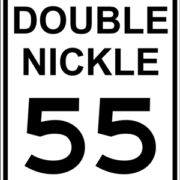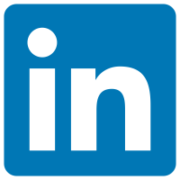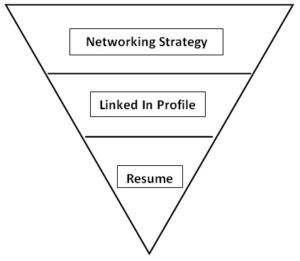“Double-nickeled and Stuck! Getting re-employed at 55 or beyond” – Part Three (c)
If you’ve tracked with us through the first four “Double-nickeled and Stuck” posts, we’ve laid a foundation for the most critical piece of a job search – networking. With an optimally leveraged LinkedIn profile that is consistent with a properly formatted resume, the pieces are in place to move to where the success of your job search has an 80%-or-better chance of happening – networking.
 That’s the reality. Over 80% of jobs are filled in this country as the result of referrals and networking. And that’s despite all the chest-thumping, flag-waving and heavy advertising by the likes of Indeed.com, ZipRecruiter, and myriad other popular job boards (has anybody seen Monster or CareerBuilder lately? – it seems they’ve left the party).
That’s the reality. Over 80% of jobs are filled in this country as the result of referrals and networking. And that’s despite all the chest-thumping, flag-waving and heavy advertising by the likes of Indeed.com, ZipRecruiter, and myriad other popular job boards (has anybody seen Monster or CareerBuilder lately? – it seems they’ve left the party).
Some people are great networkers, most aren’t. Not that they couldn’t be. There just isn’t a perceived need. For many job seekers, it’s just plain laziness combined with a low level of perceived need. Maintaining a network, let alone adding to one, isn’t a priority when you’re up to your arse in the boss’s unrealistic expectations and projects.
Chances are, that’s where you are. So, now we’re up against it and gotta do something – quickly.
So let’s cut to the chase and dispense with the network building that you should have been doing while you were employed. We need to do a frontal assault and initiate a very targeted, almost emergency-like, strategic networking plan. You don’t have time to try to connect with your brother-in-law’s sister’s cousin who is a high-powered something-or-other just because your brother-in-law said you should and so you can claim you know him/her. That’s OK if this high-powered something-or-other happens to be a potential hiring manager in your space or is connected to a potential hiring manager.
Time and focused effort are of the essence under these conditions. They need to be focused on finding a path to hiring managers.
Six part strategy
1. Get a paid LinkedIn job-seeker account. You can be on LinkedIn free – but the free account has been stripped bare since Microsoft bought LinkedIn.
You have two paid job-seeker options: Premium Career at $29.99 per month or Premium Business at $47.99. Both come with a free one-month trial. The Career package helps some but not a lot because it puts limits on who you can view and you only get three free InMails. Inmail is LinkedIn’s private email process that claims to greatly enhance your chance of getting a response from the LinkedIn member that you inmail. (Note from Gary to LinkedIn: it doesn’t so much anymore.)
You might want to consider the Business account for the purposes of your concentrated search because it gives you unlimited people-browsing of 1st- and 2nd- level connections but no visibility to 3rd-degree connections. Now, if you only have eight connections to start with, that isn’t going to help a lot so you’ll want to get your first level connections up as much as possible as quickly as possible during your search. That should result naturally as you network. Step 2 below will help you with this.

2. Take a day and start building a “tribe”. Any old Rolodexes stuffed in a closet? How about those business cards you’ve been collecting and doing nothing with? Who is in your Outlook contacts list that you’ve forgotten about? College classmates? Graduate school classmates? Your 1st level LinkedIn connections?
Your goal here is to try to come up with 100-150 names of people that you would feel comfortable calling to ask a favor.
They can fit into one of four categories:
Connectors – people who know a lot of people
Mentors – people you can learn from
Industry experts – people you need to know
Peers – who you can help and expect nothing in return
These people should become 1st level LinkedIn connections. Find them on LinkedIn and send them a connection request if they aren’t already a 1st level connection (see a suggested connection request script below in point 4).
3. Develop a target list of 30-50 companies that you may have interest in working for. This can be the toughest part of the strategy. Realistically, this list won’t all be in your existing industry, especially if you are not willing to relocate.
View it this way: you have deeply developed skills that are transferable to other industries. Open your thinking and consider other industries.
Here’s a key understanding for this step. We don’t care if they have an open position or not. So don’t limit your list to companies only posting open positions. You won’t get to 30-50 if you impose that limiter.
Here’s an example: a current coaching client is a highly-skilled marketing manager with a long, successful track record in a heavy industry niche, of which there are few other similar companies in his current location. He has no desire to relocate so he is reaching out to totally unrelated industries such as healthcare, software development, start ups. It’s been a challenge to get a list of 50 doing this but it’s developing.
4. Using LinkedIn, research and find 3-5 people to contact within those companies.
When you select a company by typing the name into the LinkedIn Search bar at the top left of your Home or Profile page, the top banner of the company will contain a live link in blue that says “See all __ employees on LinkedIn”. That’s where you will find people you may want to contact.
Most thumbnail profiles that appear will have their titles. Certainly, you will be looking for those who will likely be the decision makers for hiring someone with your background. But don’t limit it to them. Look for people that you may already know or who are doing what you do in the company, or did at one point.
At this point, you should have a range of 90-250 names to contact (30 companies x 3 contacts, 50 companies x 5 contacts). You’ll need that many because we are talking about a numbers game here which will become clearer as we work through the rest of the process.
Now, here’s where we inject a twist that most job-seekers don’t always view as rational. Don’t call these people to ask them for help in finding you a job. Why? Because people don’t like being put into that position and you will have ended a relationship before you even got started. We have a different strategy.
First, send a personalized LinkedIn connection request. You can often add a personal touch by looking for the common connections, work history, schools attended, etc.
For instance, maybe something like this:
Hi Allen. I came across your LinkedIn profile. Your career experience is very intriguing. I also see that we (have the same alma mater/we share a common acquaintance in Sadie Sue/worked at the same company back in ’08/etc.). I’d like to add you to my professional network on LinkedIn. Gary Foster
LinkedIn forces you to be succinct. You have a max of 300 characters and spaces for this connection invitation.
Once sent and accepted, you’ve now set yourself up for the key networking step.
5. Call or email with a request for an informational interview. Informational interviews are telephone or person-to-person interviews that are not designed to get you a job but to get AIR – Advice, Insight and Recommendations.
This process is NOT about making direct requests to be considered for a position. This is about building a relationship, not getting a job.

If they’ve connected with you on LinkedIn, you’ve moved from a dreaded cold call to a warm call.
The intent of the conversation is twofold: (1) to get information about the company to help you determine if it is a company that you would want to work for and (2) to position yourself for consideration for a position if one exists, or develops later.
Click here and download a document that has email and voicemail scripts that you can use to arrange these informational interviews.
If you are fortunate to have connected with someone who may be the hiring manager for your desired position, all the better. But don’t hesitate to reach out to others who may know of unposted positions or movement within the company that may be opening up opportunities in your area of expertise. Moreover, they may have a direct pipeline to the hiring manager, and, depending on your effectiveness in the informational interview, may offer to hand-walk your resume into the hiring manager, or at least encourage him/her to take your call.
Here’s a taste of the type of questions you should consider asking when in an informational interview, courtesy of Nancy Collamer, career consultant, speaker, and author at MyLifestyleCareer.com from her book “Second Act Careers”.
• What do you enjoy most about your job?
• What are the most frustrating aspects of your job?
• What are the most important characteristics for success in this career/company?
• What training should I pursue to make myself more marketable in this field?
• Which professional associations would you recommend that I join?
• What are the challenges, trends, and opportunities in this profession/company?
• Are there good options for freelance or consulting work within this industry?
• Which magazines, journals or websites do you recommend?
• Are there opportunities for flexible work arrangements?
• Is there someone else you recommend that I talk to?
• May I use your name in making the introduction?
6. The last step is to follow up. If you succeed in getting an informational interview, be sure to do the following:
• Send them an immediate note or email.
• Let them know what developed as a result of the time you spent with them, including any connections that they don’t know that came from their recommended contacts.
• Stay in touch periodically – keep them in your “tribe”.

C’mon Gary – are you serious about all this?????
Dead serious! Sound a bit daunting? Yep – it sounds daunting mostly because it’s so different from what most new job seekers think should be the approach. Today’s search requires a process. This is a process that works – when worked.
I’ve seen this work – beautifully. I’ve seen it fail – miserably. The common denominator in both situations? The job seeker. This process requires attitude, commitment, and persistence.
Go back and read Part Two in this series where we talked about attitude and commitment and the need to maintain energy through this process and guarding against overwhelm.
Plain and simple, we are suggesting you play a numbers game here that 90% or your peers won’t do. That’s why they don’t find the good jobs or get back to their previous salaries. They compromise and “settle for.” Most often, they will retreat back and follow all the sheep back into the application process.
Why 90-250 names? Simple. You’ll be lucky to get one response out of five calls you make or emails you send. 1:5 = 18 to 50 conversations. Do you think that something might develop out of that many conversations? Count on it!
Work it daily – but don’t kill yourself!
We suggested in Part Two, limit your search to thirty hours. Give this calling/emailing effort 2-3 hours a day, EVERY DAY, keeping a spreadsheet log of your calls, emails, contacts, and conversations. Have faith that it will develop.
I’ll share two contrasting experiences I’ve had with coaching clients.
Case A: a 58-year-old registered nurse with a 10-year track record as the Clinical Manager of a large urology practice. Six-figure earner with a stellar track record. Got sideways with the lead physician and walked out – and then panicked. She found me on LinkedIn, we started a coaching relationship and she followed the inverted pyramid process to the letter, including this networking strategy. Within less than six weeks, she found herself with three interviews and ended up in a dream job as a clinical liason for a cancer drug company doing what she really loves doing – educating clinicians on the efficacy of cancer drugs. She now travels extensively, makes 25% more than she was making at the urology practice and is thrilled with the new control that she has over her time.
Case B – not so good. Similar situation in some ways. Talented six-figure marketing person needing a job. Followed the inverted pyramid to the point of the networking and tried it for a while but succumbed to the difficulty and rejection in the numbers game and returned to the application process which only heightened her frustration. I couldn’t convince her to stay committed to the process and our coaching relationship dissolved. I just checked her profile – finally landed on her feet 12 months later but it appears to have required a relocation.
Trust the process – turn it into a game, a game with a very promising finish line.
P.S. Here’s a helpful hack for you. LinkedIn profiles rarely provide emails and you are limited on the number of free inmails you get. There is a Google Chrome extension called ContactOut that does an amazing job of providing emails for people you pull up on LinkedIn. Go to www.contactout.com using Chrome as your browser and download it.
The program will put a little black magnifying glass![]() on your top browser search bar. When you pull up a profile, click on the magnifying glass and a window will open in the upper right of your screen and tell you if they have an email address for that person. I have found they have emails for upwards of 70% of the people I look at. You have to be careful because some of the emails are associated with companies that the individual left, so they aren’t always current. But if they have non-company emails address like gmail or yahoo, they usually are still alive.
on your top browser search bar. When you pull up a profile, click on the magnifying glass and a window will open in the upper right of your screen and tell you if they have an email address for that person. I have found they have emails for upwards of 70% of the people I look at. You have to be careful because some of the emails are associated with companies that the individual left, so they aren’t always current. But if they have non-company emails address like gmail or yahoo, they usually are still alive.
I hope this series has been helpful. We would appreciate hearing from you as to what worked for you and what didn’t. Scroll down and leave us a comment below.










 Resume
Resume